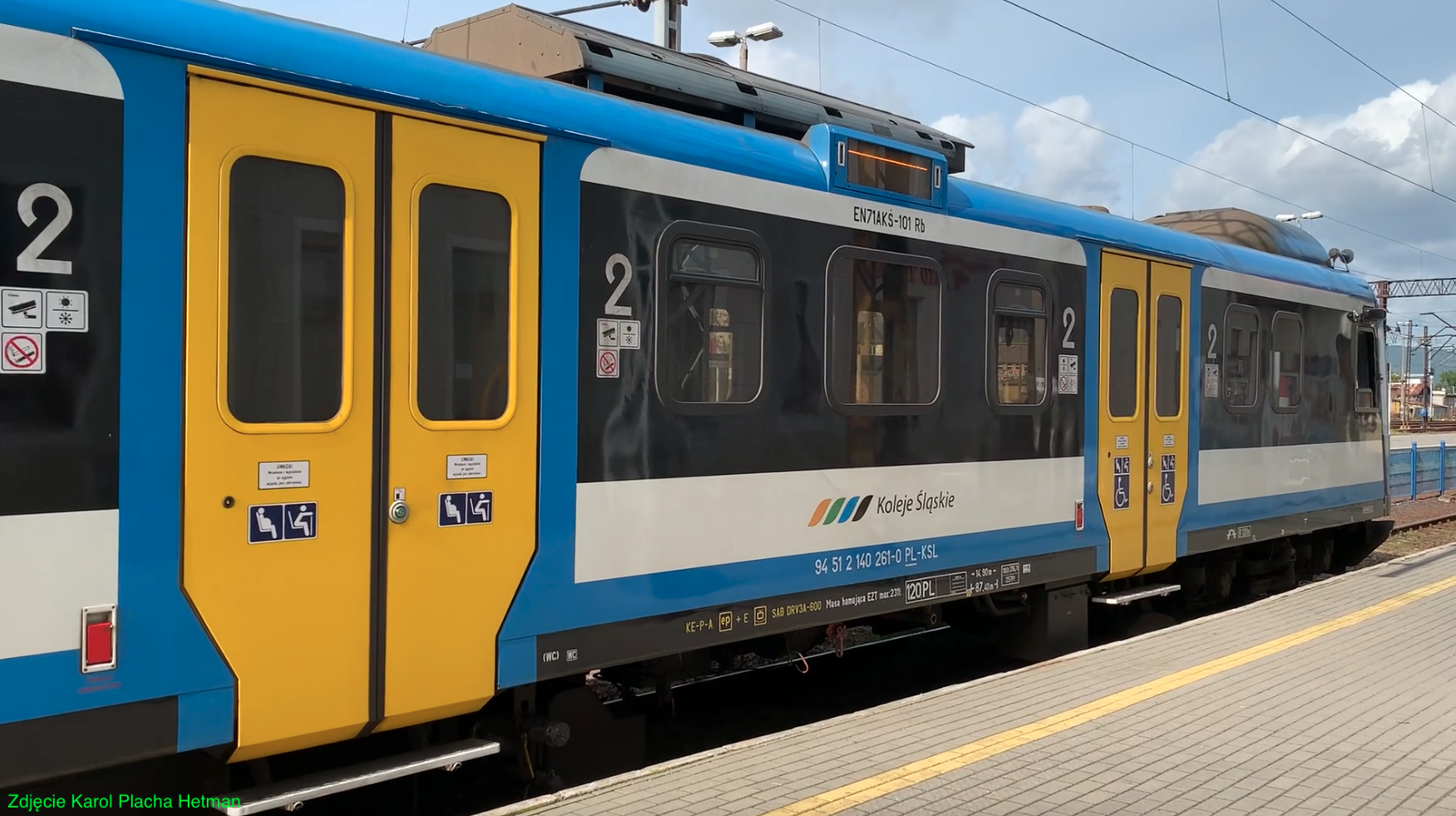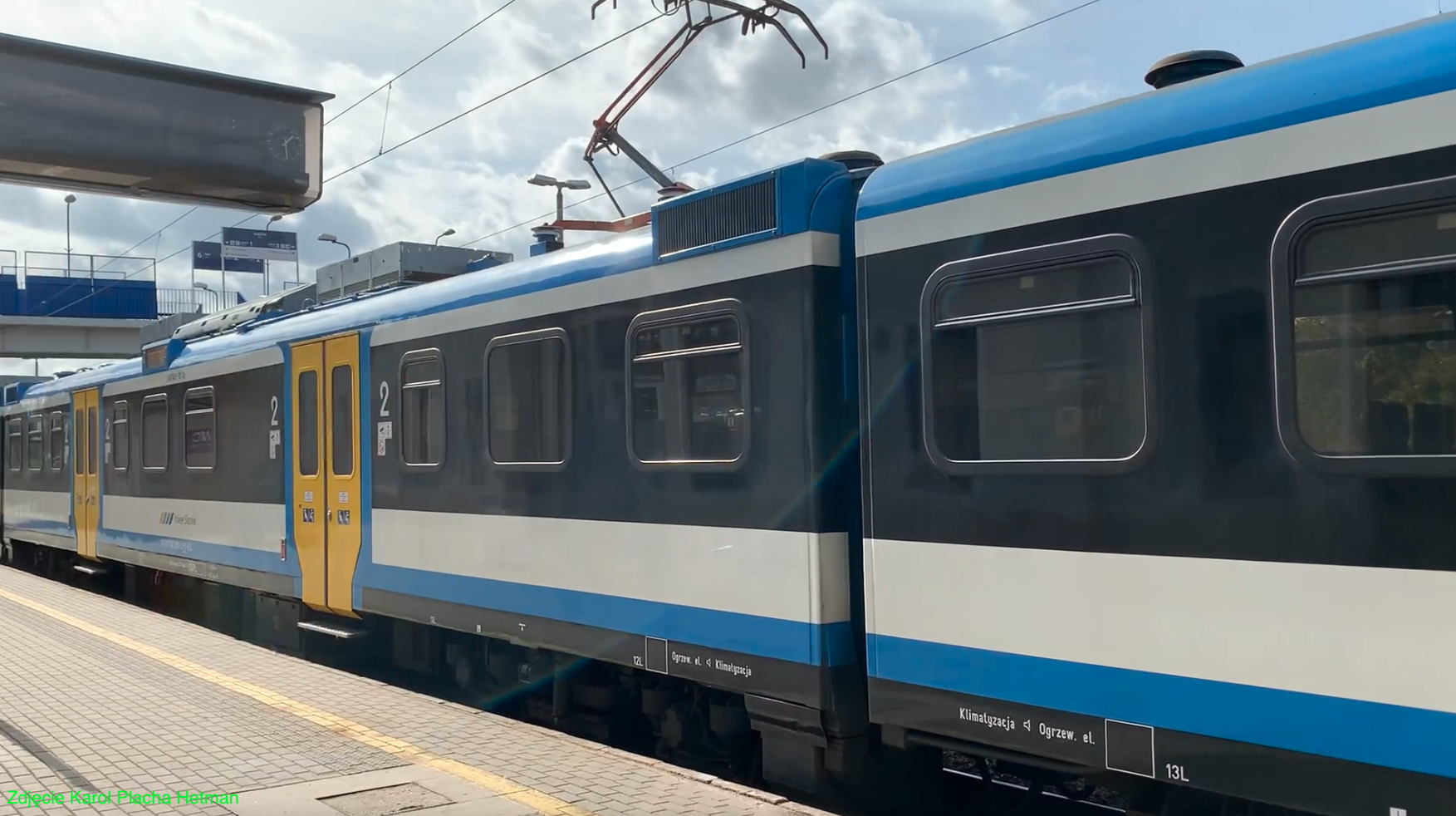Żywiec 2023-10-13
Electric Multiple Unit EN71AKŚ-101.
The EN57 Electric Multiple Unit is the legend of Polish tracks, and the EN71 EMU is the next version of this train. The prototype EN57 train made its first run in December 1961. Production was located in Wrocław at the "PaFaWag" factory. In the "PaFaWag" factory, power wagons were marked type 6B, and control and control wagons were type 5B. EN57 EMU trains were produced in series from January 1962 to July 1993, i.e. for 31 years. The EN57 train was the longest-produced rail vehicle in the world. In 2021, the 60th anniversary of the first train, an electric unit, was built. A total of 1,429 units were built. Other sources give the number of 1,452 copies, including those exported to Yugoslavia and four-car versions.
Based on the EMU EN57 composition, the "PaFaWag" factory also built four-unit units with an additional motor unit, which were marked EMU EN71. The first such train was built in 1964. In 1965, Yugoslavia bought this type of trains. Apparently, in Yugoslavia, trains were called "Gomułka" after Władysław Gomułka (first secretary of the Polish United Workers' Party), during whose times the trains were sent to the Balkans. Four-car trains were also built for long-distance traffic, marked ED72 and ED73. EW58 was built for suburban traffic. EW60 trains were built for the Tri-City railway.
Railway line No. 99 to Zakopane was electrified (3 kV DC) on December 3, 1975. The first runs made by EMU EN57 on a difficult mountain route showed that the train had insufficient power of its electric motors. The simplest solution was to add an additional power car to the EN57 set. The new train marked EN71 takes more passengers, has more power and better driving characteristics.
Construction of EN71 for PKP began in 1976. Production of the next trains started in 1981. During production, the following types of wagons were used: type 5Bh+6Bh+6Bh+5Bh, type 5B+6B+6B+5B and type 5Bg+6Bg+6Bg+5Bg. In 1976, 20 sets of EN71 EMUs were produced for PKP by PaFaWag Wrocław. In the following years, 31 EN71 EMUs were created by assembling individual units in ZNTK in various railway directorates. In the following years, wagons that returned to Poland from the countries of former Yugoslavia were also used. Since the conversion of EN57 trains into EN71 is very simple, many modified EMUs were created in the following years.
PaFaWag EN71 T-T data:
Layout of wagons; timing + engine + engine + timing. Axle system; 2'2'+Bo'Bo'+Bo'Bo'+2'2'. Service weight 182,000 kg. Length 86.84 m. Width 2.88 m. Height 3.72 m. Diameter of driving wheels 1.00 m. Diameter of rolling wheels 0.94 m. Power supply 3 kV DC. Oerlikon type braking system.
Due to the many years of operation of the EN71 EMU trains, they have different engines. Classic engines LKf-450 (8 x 145 kW) continuous power 1,160 kW or LKa-470 (8 x 175 kW) continuous power 1,400 kW. Or asynchronous motors with a power of 8 x 250 kW, continuous power of 2,000 kW. Resistance starting is used in the EN71 EMU. Design speed 110 km/h (acceleration 0.6 m/s2), and with asynchronous motors 120 km/h (acceleration 1.4 m/s2).
The entrance door has an entrance threshold at a height of 1.15 m from the rail head. There are 264 seats in the train. The train takes up to 888 passengers with a density of 5 people per square meter. The wagons are connected to each other by a short "factory" coupler and there is a passage for passengers and train staff. Automatic Scharfenberg couplers are installed on the fronts of the EMUs, which enable the units to be connected into sets for repeated driving. EN71 can be combined with EN57 and ED72.
The wagon base is made of steel profiles connected by welding. The end caps are made as high-strength closed profiles. The sides of the wagons in the first trains are grooved. From train No. 21, the sides of the wagons were made smooth. You can find EMUs where some of the wagons have grooved sides, and some have smooth sides. The interior of the wagons is identical to that of the EN57 EMU.
Each of the outer wagons is based on two bogies with a wheelbase of 2.70 m. The wheels of the bogies are made of St65P steel, they have a diameter of 0.94 m. Each of the middle wagons is based on two drive bogies with a wheelbase of 2.70 m. The diameter of the wheels is 1.00 m. The bogies have hydraulic shock absorbers, leaf springs and coil springs. Each EN71 EMU has four current collectors, two on the middle wagons. While the train is moving, the second and fourth collectors are raised, looking in the direction of travel.
EMU EN71AKŚ-101.
EMU EN71AKŚ-101 is a modernized EMU EN71 by NEWAG for Koleje Śląskie. Two such vehicles were modernized: EN71AKŚ-100, EN71AKŚ-101. Both trains went to Koleje Śląskie.




The EN71AKŚ-101 EMU vehicle consists of four wagons: 94 51 2 140 258-6, 94 51 2 140 259-2, 94 51 2 140 260-2, 94 51 2 140 261-0. The train was produced in 1975 and handed over to the railways in Yugoslavia. After the collapse of Yugoslavia, the train was operated in Slovenia. Before 2010, the train returned to Poland. The train was taken over by the Silesian Railways and underwent renovation. The renovation was carried out in Nowy Sącz by NEWAG. The renovation was carried out at the P5 + NG level. The interior of the vehicle has been completely changed. Air conditioning has been installed. The doors were changed to spring and slide doors. The painting was changed to the typical painting of the Silesian Railways. The renovation was completed on November 24, 2012.
In 2017, a P4 level repair was carried out at ZNTK Mińsk Mazowiecki. The renovation was completed on December 20, 2017.
In 2022, another repair at the P4 level was carried out at PESA Minsk Mazowiecki. The renovation was completed on December 3, 2022. Koleje Śląskie announced a tender for this renovation. The tender included two EN71AKŚ trains and two 14WE trains. PLN 13,111,800 was allocated for this task. Two renovation companies took part in the tender; PESA Zakłady Naprawcze Taboru Kolejowego "Mińsk Mazowiecki" with a gross price of PLN 9,953,160. Consortium - Serwis Pojazdów Szynowych (leader) and Public Transport Service with a gross price of PLN 8,892,900. Despite the higher price, the offer of PESA Minsk Mazowiecki was selected. As part of additional work on EN71AKŚ-101 and EN71AKŚ, the company required the delivery and installation of new passenger counting sensors and their full integration with the current passenger information system, as well as the replacement of the video monitoring system.
EMU EN71AKŚ-100.
The second train of Koleje Śląskie is EMU EN71AKŚ-100, which consists of wagons; 94 51 2 140 254-5, 94 51 2 140 255-2, 94 51 2 140 256-0, 94 51 2 140 257-8. The train was produced in 1966.
EMU EN71AKŚ-101 - description of the train.
Layout of wagons; timing + engine + engine + timing. Axle system; 2'2'+Bo'Bo'+Bo'Bo'+2'2'. Service weight approximately 190,000 kg. Length 88.50 m. Width 2.90 m. Height 3.90 m. Braking system with energy recovery. Power supply 3 kV DC. The train is powered by asynchronous engines with a power of 8 x 250 kW. The letter "A" in the train's marking indicates the installation of asynchronous motors. The continuous power is 2,000 kW. The design speed is 120 km/h and the acceleration is 1.4 m/s2. Only two current collectors (pantographs) were installed in the train, of the half type, with double sliders. They were placed on motor cars. There are also power inverters on the roof to power the traction motors.
The Electric Multiple Unit consists of four wagons (units). The vehicle is designed to transport 256 passengers on individual seats, and an additional 260 passengers in a standing position. The seats are made using impact-resistant technology. The train is adapted to transport passengers in wheelchairs. Ramps were installed to enter the vehicle. There are two toilets on board, and one of them is adapted for disabled people. The vehicle can accommodate bicycles, strollers and larger luggage.
The train was equipped with air conditioning. The external units were mounted on the roofs of the carriages. Mechanics' cabins have individual air conditioning. For passengers, there is one air conditioning on each section. Of course there is also heating. The train is equipped with an audio and video passenger information system. The train is monitored and has a passenger counting system. The interior of each carriage is single-space.
The wagons are connected to each other by a short "factory" coupler and there is a passage for passengers and train staff. Automatic Scharfenberg couplers are installed on the fronts of the EMUs, which enable the units to be connected into formations. When not in use, the coupling is secured with a synthetic leather bag.
There are engineer's (driver's) cabins at both ends of the train. The steel cage is made of welded closed profiles and is attached to the frame and the rest of the wagon body. The front wall is covered with plastic. The train's headstock is equipped with a large panoramic window, which is equipped with two windshield wipers. Five lights were also installed; two red and three white (halogen headlights). The cover placed above the cabin hides the air conditioning for the driver.
The wagon base is made of steel profiles connected by welding. Each wagon is based on two two-axle bogies. Each carriage is equipped with two pairs of spring-sliding doors that open automatically, either outside or inside, after pressing the green button. There is one fixed entrance step under the door. The windows in the carriages are double-glazed. Every second window has an additional window. In the upper part of the side of the wagons there are railway information displays and ventilation and air-conditioning system grilles.
The train is painted in the colors of the Silesian Railways; white and blue. Additionally, there is a wide black strip at the height of the windows. The doors are painted yellow, which makes it very easy to locate the entrances. There are pictograms on the doors with important information, for example; entry of passengers with bicycles.
Written by Karol Placha Hetman
